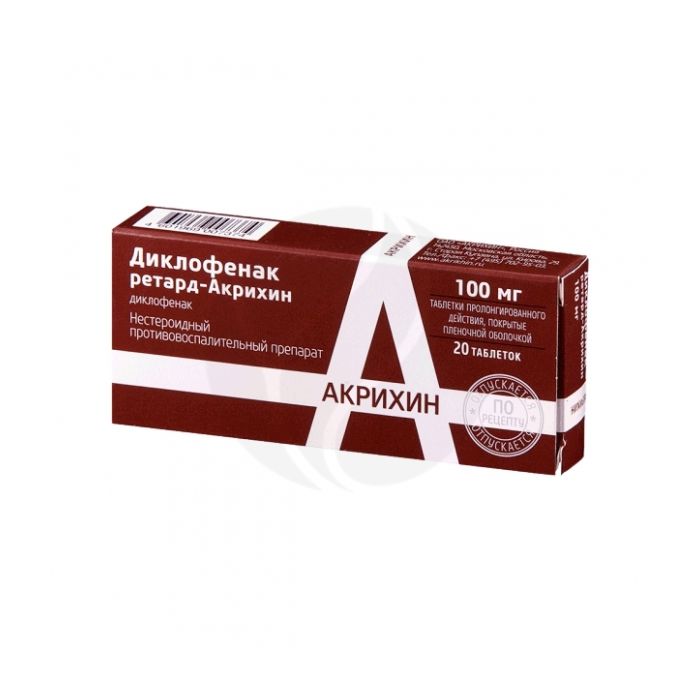Diclofenac retard tablets 100mg, No. 20
Expiration Date: 05/2027
Russian Pharmacy name:
Диклофенак ретард таблетки 100мг, №20
Inflammatory and degenerative diseases of the musculoskeletal system: rheumatoid arthritis, juvenile rheumatoid arthritis, ankylosing spondylitis, osteoarthritis, spondyloarthritis, osteoarthritis;
Spine diseases accompanied by pain syndrome;
Rheumatic diseases of extra-articular soft tissues;
Post-traumatic and postoperative pain syndromes, accompanied by inflammation and edema;
Gynecological diseases accompanied by pain and inflammation (for example, primary algomenorrhea, adnexitis);
The tablets should be swallowed whole with a liquid, preferably before meals.
For adults, the recommended starting dose is 100-150 mg / day. In relatively mild cases of the disease, as well as for long-term therapy, 75-100 mg / day is sufficient.
The daily dose should be divided into several doses. If necessary, to act on night pain or morning stiffness, in addition to taking the drug during the day, Voltaren is prescribed in the form of suppositories at bedtime; in this case, the total daily dose should not exceed 150 mg. The dosage is selected by the attending physician.
Active substance:
diclofenac
-A stomach or intestinal ulcer;
- anamnestic information about attacks of bronchial asthma, urticaria, acute rhinitis associated with the use of acetylsalicylic acid or other NSAIDs, as well as any drugs that suppress the production of prostaglandins;
- hematopoiesis disorders;
-Children up to 14 years old;
- hypersensitivity to diclofenac and any other ingredients of the drug.
Pharmacological action
Diclofenac is a non-steroidal anti-inflammatory drug (NSAID). It has anti-inflammatory, analgesic and antipyretic effects. Inhibits the COX enzyme in the cascade of arachidonic acid metabolism and disrupts the biosynthesis of prostaglandins.
Indications
Inflammatory and degenerative diseases of the musculoskeletal system: rheumatoid arthritis, juvenile rheumatoid arthritis, ankylosing spondylitis, osteoarthritis, spondyloarthritis, osteoarthritis;
Spine diseases accompanied by pain syndrome;
Rheumatic diseases of extra-articular soft tissues;
Acute gout attack (only for enteric-coated tablets);
Post-traumatic and postoperative pain syndromes, accompanied by inflammation and edema;
Gynecological diseases accompanied by pain and inflammation (for example, primary algomenorrhea, adnexitis);
Contraindications
- stomach or intestinal ulcer;
- anamnestic information about attacks of bronchial asthma, urticaria, acute rhinitis associated with the use of acetylsalicylic acid or other NSAIDs, as well as any drugs that suppress the production of prostaglandins;
-proctitis (only for suppositories);
- hematopoiesis disorders;
-Children up to 14 years old;
- hypersensitivity to diclofenac and any other ingredients of the drug.
Method of administration and dosage
The tablets should be swallowed whole with a liquid, preferably before meals.
For adults, the recommended starting dose is 100-150 mg / day. In relatively mild cases of the disease, as well as for long-term therapy, 75-100 mg / day is sufficient.
The daily dose should be divided into several doses. If necessary, to act on night pain or morning stiffness, in addition to taking the drug during the day, Voltaren is prescribed in the form of suppositories at bedtime; in this case, the total daily dose should not exceed 150 mg. The dosage is selected by the attending physician.
Side effects
Abdominal pain, bloating, diarrhea, nausea, constipation, flatulence, increased levels of liver enzymes, peptic ulcer with possible complications (bleeding, perforation), gastrointestinal bleeding, headache, dizziness, tinnitus, skin itching, skin rash, fluid retention.
Overdose There is no
typical clinical picture characteristic of an overdose of Voltaren.
Symptoms: decreased blood pressure, renal failure, seizures, gastrointestinal disturbances and respiratory depression.
Treatment: supportive and symptomatic. It is unlikely that forced diuresis, hemodialysis, or hemoperfusion will be beneficial for the elimination of NSAIDs. the active substances of these drugs to a large extent bind to plasma proteins and are extensively metabolized.

